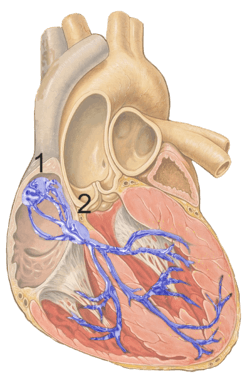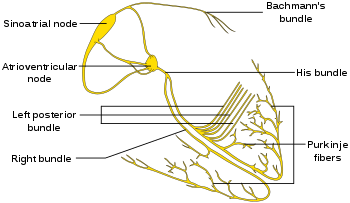Atrioventricular node
The atrioventricular node or AV node is a part of the electrical conduction system of the heart that coordinates the top of the heart. It electrically connects the atria and ventricles.[1] The AV node lies at the lower back section of the interatrial septum near the opening of the coronary sinus, and conducts the normal electrical impulse from the atria to the ventricles. The AV node is quite compact (~1 x 3 x 5 mm).[2]
| Atrioventricular node | |
|---|---|
 Image showing the conduction system of the heart. The AV node is labelled 2. | |
| Details | |
| System | Electrical conduction system of the heart |
| Artery | Atrioventricular nodal branch |
| Identifiers | |
| Latin | Nodus atrioventricularis |
| Acronym(s) | AV node |
| MeSH | D001283 |
| TA | A12.1.06.004 |
| FMA | 9478 |
| Anatomical terminology | |
Structure
Location
The AV node lies at the lower back section of the interatrial septum near the opening of the coronary sinus, which conducts the normal electrical impulse from the atria to the ventricles. The AV node is quite compact (~1 x 3 x 5 mm).[2] It is located at the center of Koch's triangle—a triangle enclosed by the septal leaflet of the tricuspid valve, the coronary sinus, and the membranous part of the interatrial septum.[3]
Blood supply
The blood supply of the AV node is from the atrioventricular nodal branch. The origin of this artery is most commonly (80-90% of hearts) a branch of the right coronary artery, with the remainder originating from the left circumflex artery.[4][5][6] This is associated with the dominance of the coronary artery circulation. In right-dominant individuals the blood supply is from the right coronary artery while in left dominant individuals it originates from the left circumflex artery.
Development
BMP (Bone morphogenetic protein) cell signaling plays a key role in diverse aspects of cardiac differentiation and morphogenesis. (BMPs) are multifunctional signaling molecules critical for the development of AV node. BMP influences AV node development through Alk3 receptor (Activin receptor-like kinase 3). Abnormalities seen in BMP and Alk3 are associated with some cardiovascular diseases like Ebstein’s anomaly and AV conduction disease.[7]
Function

The AV node receives two inputs from the right atrium: posteriorly, via the crista terminalis, and anteriorly, via the interatrial septum.[8]
Contraction of heart muscle cells requires depolarization and repolarization of their cell membranes. Movement of ions across cell membranes causes these events. The cardiac conduction system (and AV node part of it) coordinates myocyte mechanical activity. A wave of excitation spreads out from the sinoatrial node through the atria along specialized conduction channels. This activates the AV node.[1] The atrioventricular node delays impulses by approximately 0.09s. This delay in the cardiac pulse is extremely important: It ensures that the atria have ejected their blood into the ventricles first before the ventricles contract.[9]
This also protects the ventricles from excessively fast rate response to atrial arrhythmias (see below).[10]
AV conduction during normal cardiac rhythm occurs through two different pathways:
- the first “pathway” has a slow conduction velocity but shorter refractory period
- the second “pathway” has a faster conduction velocity but longer refractory period.[11]
An important property that is unique to the AV node is decremental conduction,[12] in which the more frequently the node is stimulated the slower it conducts. This is the property of the AV node that prevents rapid conduction to the ventricle in cases of rapid atrial rhythms, such as atrial fibrillation or atrial flutter.
The AV node's normal intrinsic firing rate without stimulation (such as that from the SA node) is 40-60 times/minute.[13] This property is important because loss of the conduction system before the AV node should still result in pacing of the ventricles by the — slower — pacemaking ability of the AV node.
Clinical significance
- Atrioventricular conduction disease (AV block) describes impairment of the electrical continuity between the atria and ventricles. It occurs when the atrial depolarization fail to reach the ventricles or is conducted with an abnormally long delay. It can result from an injury or be a genetically inherited disorder.[14]
- Atrioventricular nodal re-entry tachycardia.[11]
- Cystic tumour of atrioventricular nodal region (CTAVN) CTAVN is of endodermal origin and occurs exclusively in the area of the AV node, tricuspid valve, and interatrial septum.[15]
See also
References
- Gray, Huon H.; Keith D. Dawkins; Iain A. Simpson; John M. Morgan (2002). Lecture Notes on Cardiology. Boston: Blackwell Science. p. 135. ISBN 978-0-86542-864-5.
- Full Size Picture triangle of-Koch.jpg. Retrieved on 2008-12-22
- Harrison's Principles of Internal Medicine, 17e” Section 3: Disorders of Rhythm Archived July 7, 2011, at the Wayback Machine
- Van der Hauwaert LG, Stroobandt R, Verhaeghe L (October 1972). "Arterial blood supply of the atrioventricular node and main bundle". British Heart Journal. 34 (10): 1045–51. doi:10.1136/hrt.34.10.1045. PMC 458545. PMID 5086972.
- Pejković, B.; Krajnc, I.; Anderhuber, F.; Kosutić, D. (2008). "Anatomical aspects of the arterial blood supply to the sinoatrial and atrioventricular nodes of the human heart". The Journal of International Medical Research. 36 (4): 691–698. doi:10.1177/147323000803600410. PMID 18652764.
- Saremi, F.; Abolhoda, A.; Ashikyan, O.; Milliken, J. C.; Narula, J.; Gurudevan, S. V.; Kaushal, K.; Raney, A. (2007). "Arterial Supply to Sinuatrial and Atrioventricular Nodes: Imaging with Multidetector CT". Radiology. 246 (1): 99–107, discussion 108–9. doi:10.1148/radiol.2461070030. PMID 18024438.
- Stroud DM, Gaussin V, Burch JB, et al. (November 2007). "Abnormal Conduction and Morphology in the Atrioventricular Node of Mice With Atrioventricular Canal–Targeted Deletion of Alk3/Bmpr1a Receptor". Circulation. 116 (22): 2535–43. doi:10.1161/CIRCULATIONAHA.107.696583. PMC 2947829. PMID 17998461.
- Fuster V, Rydén LE, Asinger RW, et al. (October 2001). "ACC/AHA/ESC guidelines for the management of patients with atrial fibrillation" (PDF). Journal of the American College of Cardiology. 38 (4): 1231–66. doi:10.1016/S0735-1097(01)01587-X. PMID 11583910.
- Campbell, N., & Reece, J. (2002). Biology. 6th ed. San Francisco: Benjamin Cummings
- Gray, Huon H.; Keith D. Dawkins; Iain A. Simpson; John M. Morgan (2002). Lecture Notes on Cardiology. Boston: Blackwell Science. p. 136. ISBN 978-0-86542-864-5.
- Gray, Huon H.; Keith D. Dawkins; Iain A. Simpson; John M. Morgan (2002). Lecture Notes on Cardiology. Boston: Blackwell Science. p. 157. ISBN 978-0-86542-864-5.
- Patterson E, Scherlag BJ (October 2002). "Decremental conduction in the posterior and anterior AV nodal inputs". Journal of Interventional Cardiac Electrophysiology. 7 (2): 137–48. doi:10.1023/A:1020833604423. PMID 12397223.
- Guyton, Arthur C.; John E. Hall (2006). Textbook of Medical Physiology (11 ed.). Philadelphia: Elsevier Saunders. p. 120. ISBN 978-0-7216-0240-0.
- Benson DW (October 2004). "Genetics of atrioventricular conduction disease in humans". The Anatomical Record Part A: Discoveries in Molecular, Cellular, and Evolutionary Biology. 280 (2): 934–9. doi:10.1002/ar.a.20099. PMID 15372490.
- Sharma G, Linden MD, Schultz DS, Inamdar KV (January 2009). "Cystic tumor of the atrioventricular node: an unexpected finding in an explanted heart". Cardiovascular Pathology. 19 (3): e75–8. doi:10.1016/j.carpath.2008.10.011. PMID 19144541.
External links
- Anatomy figure: 20:06-02 at Human Anatomy Online, SUNY Downstate Medical Center - "The conduction system of the heart."
- thoraxlesson4 at The Anatomy Lesson by Wesley Norman (Georgetown University) (thoraxheartinternalner)
- https://web.archive.org/web/20070929080346/http://www.healthyheart.nhs.uk/heart_works/heart03.shtml